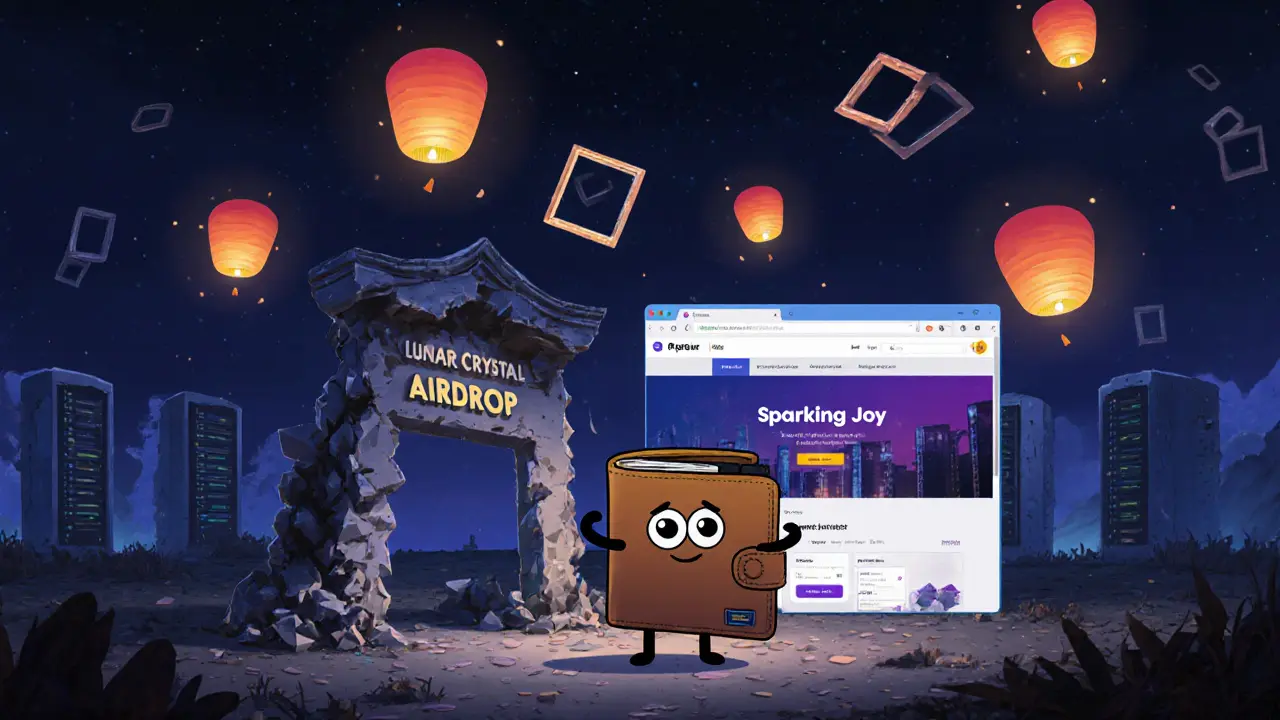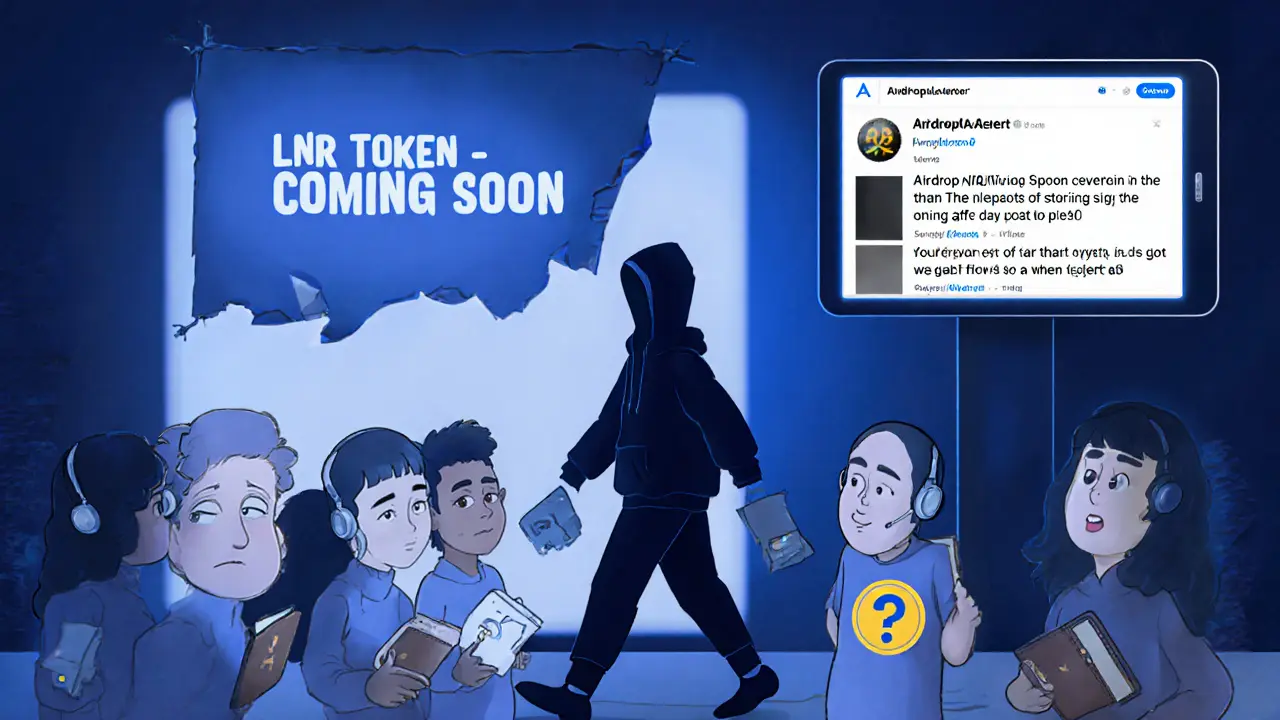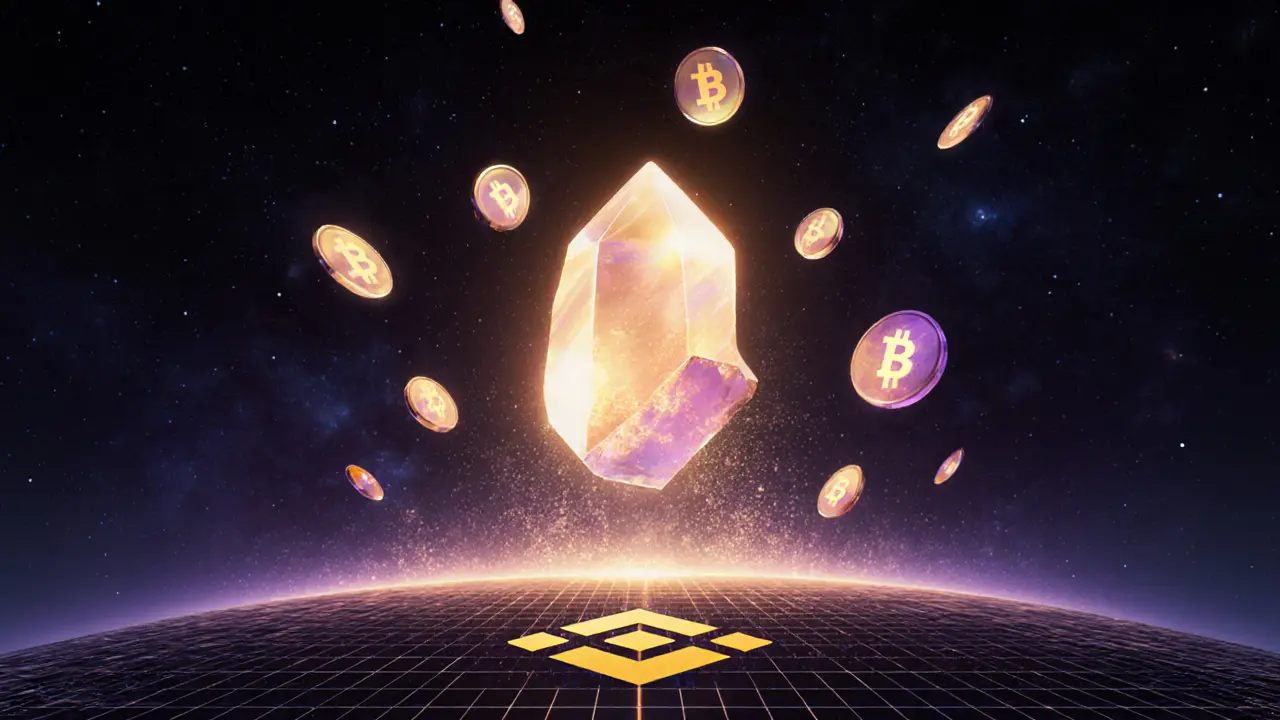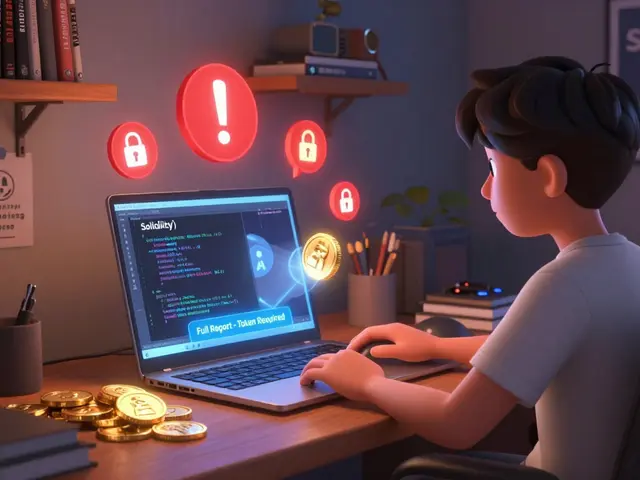Airdrop Legitimacy Checker
Check Airdrop Legitimacy
This tool helps you determine if an NFT airdrop is legitimate based on the key criteria identified in the Lunar Crystal NFT airdrop case study. Use it before claiming any airdrop.
Check all criteria that apply to the airdrop:
The Lunar Crystal NFT airdrop was supposed to be the gateway into something bigger - a DeFi ecosystem called Lunar, built on Binance Smart Chain, promising passive earnings and a magical on-ramp for new crypto users. It launched on March 1, 2022, with a simple promise: complete a few tasks, get at least one NFT. No VIP tiers. No mint fees. Just join through CoinMarketCap and you’re in. But today, nearly three years later, there’s no trace of it. No website. No NFTs in wallets. No community. No explanation. What went wrong?
How the Lunar Crystal NFT Airdrop Was Supposed to Work
The airdrop was tied to the LNR token, which was meant to be the heartbeat of Lunar’s ecosystem. Holders would earn rewards just by holding - no staking, no locking, no complicated steps. That alone made it stand out in early 2022, when most DeFi projects demanded you lock up your assets for months just to earn a few percent.
To get the NFT, you had to connect your BSC wallet - usually MetaMask or Trust Wallet - to CoinMarketCap’s platform. That was the only real requirement. You also needed a Twitter account and a CoinMarketCap profile. That’s it. No KYC. No deposit. No gas fees beyond the standard network cost to claim. It sounded too easy. And for a while, it looked like it might be real.
Unlike other NFT airdrops that launched with flashy art and rarity tiers, Lunar Crystal didn’t show any visuals. No trait breakdowns. No supply numbers. No roadmap. Just a promise: “You’ll get at least one NFT.” That vagueness was the first red flag. Most legitimate projects back then - like Baby Ape Beast or Luna’s LSTR token - published detailed trait lists, artist credits, and even metadata storage methods. Lunar didn’t. Not even a single image.
Why It Never Took Off
There were three big reasons this airdrop fizzled.
First, the platform didn’t deliver on its core promise. If you claimed your NFT, you never saw it. No wallet notification. No transaction on BscScan. No collection on OpenSea or LooksRare. People who claimed it in March 2022 still have empty wallets today. No one knows if the NFTs were minted at all.
Second, there was zero transparency. No whitepaper. No GitHub. No smart contract address ever published. No audit from CertiK or OpenZeppelin. In a space where security is everything, that’s a death sentence. Even small projects in 2022 published their contracts. Lunar didn’t. That meant users had no way to verify if the airdrop was real - or if their wallet addresses were just being collected for spam.
Third, the team vanished. Lunar.io’s website, which once talked about “revolutionizing crypto interfaces,” now focuses on vague phrases like “sparking joy in your everyday Web3 experiences.” No mention of LNR. No mention of NFTs. No mention of the airdrop. It’s like the entire project was erased. No Twitter updates. No Discord replies. No Reddit threads from users complaining or celebrating. Just silence.
How It Compared to Other Airdrops in 2022
March 2022 was the peak of NFT airdrop mania. Over 120 projects launched that month alone. Most were messy. But most at least tried to be transparent.
Baby Ape Beast, for example, gave users a clear list of 150 traits, published the smart contract, and held a public mint after the airdrop. They had a Discord with 50,000 members. Luna’s LSTR airdrop had a Telegram bot that walked users through each step. Even small projects had support channels.
Lunar had none of that. It relied entirely on CoinMarketCap’s platform - which, at the time, was still testing its own NFT airdrop tools. CoinMarketCap never confirmed it was officially hosting Lunar’s drop. That left users in a gray zone: was this a real partnership, or just a third-party site scraping data?
And then there was the blockchain choice. BSC was popular because gas fees were cheap - but it was also known for scams. In 2022, over 60% of failed NFT projects were on BSC. Lunar didn’t help its case by offering zero proof of legitimacy.

What Happened to the LNR Token?
The LNR token was supposed to be the key to everything. Hold it, earn rewards. Simple. But even the token never launched properly.
No exchanges listed it. No wallets showed it. No contract address was ever published. You couldn’t buy it. You couldn’t trade it. You couldn’t even check its balance. If you found LNR on a token tracker, it was a fake - likely a rug pull token with zero liquidity.
Compare that to Scroll or Linea, which launched their tokens later in 2022 with full audits, liquidity pools, and listings on major exchanges. Their airdrops had real value because the tokens were real. LNR had nothing. Not even a name on CoinGecko.
Why You Should Never Trust an Airdrop Without Proof
This isn’t just a story about a failed project. It’s a lesson.
If an airdrop doesn’t show you the smart contract, don’t participate. If it doesn’t have a GitHub, don’t trust it. If the team disappears after the drop, you’re already too late. And if the NFTs never show up in your wallet - they never existed.
Back in 2022, people lost millions to fake airdrops. Lunar Crystal wasn’t the biggest, but it was one of the quietest. No drama. No complaints. Just silence. That’s the scariest kind.
Today, airdrops are smarter. Projects like Arbitrum, Optimism, and zkSync all published detailed claim guides, contract addresses, and audit reports. They even gave users step-by-step video tutorials. Lunar didn’t do any of that.

Is There Any Way to Claim Lunar Crystal NFTs Today?
No.
The airdrop window closed in March 2022. The website has changed focus. The token is gone. The NFTs never existed. Even if you completed every task, you didn’t get anything.
There’s no official support channel. No email address. No Twitter reply. No archived page that still works. The only record of this airdrop is a single blog post from AirdropAlert from March 2022 - and even that’s been archived, not updated.
If you think you’re eligible, don’t waste time. Don’t connect your wallet. Don’t click any links. There’s nothing to claim.
What You Can Learn From This
This isn’t just about Lunar. It’s about how to spot a dead airdrop before you get burned.
Here’s what to check every time:
- Smart contract address? If they won’t give it, walk away.
- Audit report? No audit = high risk.
- Is the NFT collection live? Check OpenSea, Blur, or Magic Eden. If it’s not there, it doesn’t exist.
- Is the team active? Are they replying to questions? Do they have a real Discord or Telegram?
- Is the project still around? Check the website. If the homepage changed to something unrelated, the airdrop is dead.
Lunar Crystal NFT was a ghost project. It appeared, promised something, and vanished. No one was hurt because no one lost money - but a lot of people lost trust. And that’s the real cost.
Did anyone actually receive the Lunar Crystal NFT?
No verified reports exist of anyone receiving the Lunar Crystal NFT. No NFTs appear on BSC-based marketplaces like OpenSea or LooksRare. No wallet addresses show the NFT in their holdings. The project never published a smart contract or collection address, making it impossible to verify claims. All evidence suggests the NFTs were never minted.
Can I still claim the Lunar Crystal NFT today?
No. The airdrop officially ended in March 2022. The Lunar website no longer mentions NFTs, the LNR token, or the airdrop. CoinMarketCap has removed all references to the campaign. There is no active portal, no claim button, and no support channel. Any website claiming to offer the NFT now is likely a scam.
What was the LNR token used for?
LNR was described as a token for passive earnings within Lunar’s DeFi ecosystem. Holders were promised rewards just for holding the token. But the token was never listed on any exchange, never had a smart contract, and never had liquidity. It did not function as a real cryptocurrency. No one ever owned or traded it legitimately.
Was Lunar Crystal NFT a scam?
It wasn’t a classic scam where users lost money - because no one paid anything. But it was a deceptive project. It created false expectations, collected user data (wallets, social accounts), and then disappeared without delivering anything. That’s a form of fraud, even if no funds were stolen.
Why did Lunar disappear?
Lunar likely pivoted away from NFTs and DeFi after the airdrop failed to gain traction. With no community, no token adoption, and no NFTs in wallets, the project had no foundation to build on. The team likely shifted focus to other products - possibly under the same domain - but abandoned the crypto-native goals entirely. The website today is vague and non-technical, suggesting a move away from blockchain.
Should I participate in similar airdrops now?
Only if they meet three criteria: 1) They publish a verifiable smart contract address, 2) They have a public audit from a trusted firm like CertiK, and 3) The NFTs are already live on a major marketplace. If any of those are missing, treat it as a warning sign. Most airdrops today are low-risk, but Lunar Crystal proves that even “free” things can be traps.




24 Comments
angela sastre
So many people got burned by this. I remember checking my wallet every day for weeks hoping the NFT would pop up. It never did. No email, no update, nothing. Just silence. I learned my lesson: if they don’t show the contract, it’s not real. Don’t trust vibes, trust code.
Patrick Rocillo
lmao i still laugh thinking about this. like... ‘join via CoinMarketCap and get magic space crystals’ 🤡 no art, no contract, no team, just a ghost in the machine. i swear, if i see one more ‘free NFT’ with zero transparency, i’m gonna scream into the void. 🌕💎💀
Aniket Sable
this was so wild. i did all the steps and got nothing. no nft, no token, no reply. just crickets. i thought maybe my wallet was glitched. turns out the whole thing was smoke. sad.
Santosh harnaval
The silence speaks louder than any scam alert. No updates. No explanation. Just gone. That’s the real danger - not losing money, but losing faith.
Rampraveen Rani
I still check my wallet every now and then like a fool 😅 maybe one day the crystals will appear 🌌✨
Prabhleen Bhatti
Let’s be clear: this wasn’t just a failed project - it was a structural failure of accountability in Web3. No smart contract? No audit? No public team? That’s not negligence - that’s predatory design. The fact that users didn’t lose funds doesn’t make it ethical; it makes it a psychological exploit. You harvested trust without offering value. That’s worse than a rug pull - it’s a soul pull.
Elizabeth Mitchell
I remember seeing this pop up on my CoinMarketCap feed and thinking, ‘Huh, interesting.’ Then I forgot about it. Honestly, I didn’t even know it was supposed to be a thing until now. Kinda makes you wonder how many other quiet disappearances are out there.
Chris Houser
For new folks coming into crypto, this is a textbook case of what not to do. You don’t need fancy tech to build trust - you just need honesty. Publish your contract. Show your face. Answer questions. If you can’t do that, don’t ask people to give you their wallet. It’s not just bad practice - it’s disrespectful.
William Burns
One must question the epistemological validity of any digital asset that lacks ontological grounding in a verifiable blockchain registry. The absence of a publicly audited smart contract constitutes not merely a failure of execution, but an ontological nullity - a non-entity masquerading as a token. This is not a failure of marketing; it is a failure of metaphysics.
Ashley Cecil
It is deeply irresponsible to promote an ‘airdrop’ with no contract address, no audit, and no verifiable team. This isn’t ‘innovation’ - it’s fraud. And the fact that people still treat this as a ‘lesson’ rather than a criminal act is alarming. You don’t get to disappear after collecting wallet addresses and social handles and call it ‘quiet.’ You call it theft of consent.
John E Owren
I’m glad someone finally wrote this. I was one of the ones who claimed it. I didn’t say anything because I thought I messed up. Turns out, I didn’t do anything wrong - the project just ghosted. It’s not just about money. It’s about respect. They treated us like test subjects, not users.
Joseph Eckelkamp
Oh wow, another ‘magic NFT’ that vanished like my ex’s texts. 🙄 Let me guess - the team ‘pivoted to Web3 joy’? Yeah, right. They pivoted from ‘we’ll give you free digital junk’ to ‘we’ll sell you NFT-themed merch on Shopify.’ Classic. The real crime? People still fall for this. If you’re not showing the contract, you’re not building - you’re baiting. And we’re all the fish.
Jennifer Rosada
It’s not just that the NFTs didn’t exist - it’s that the project actively misled users into believing they were part of something meaningful. That’s not a mistake. That’s manipulation. And the fact that the website now promotes ‘sparking joy’ while erasing its entire crypto history? That’s gaslighting in blockchain form. You don’t get to rewrite history and call it a pivot.
adam pop
Think about it - CoinMarketCap doesn’t even confirm they partnered with Lunar. What if this was a data harvest? What if every wallet address collected was sold to phishing sites? What if the ‘tasks’ were just ways to verify which wallets were active for future scams? They didn’t vanish… they just moved on to the next target.
Dimitri Breiner
People need to stop acting like this is some ‘learning experience.’ This was a trap. They didn’t just disappear - they disappeared after collecting your data. That’s not a ghost project. That’s a ghost hunter. And if you’re still trusting ‘free’ NFTs without a contract, you’re not naive - you’re reckless.
LeAnn Dolly-Powell
I felt so bad for the people who spent hours on this. I didn’t do it, but I saw friends who did. They were so excited. And then… nothing. It’s not just about the NFT - it’s about the hope they invested. That’s the real loss. We need more empathy in crypto, not just ‘HODL’ memes.
Anastasia Alamanou
It’s fascinating how the industry normalizes this. We accept ‘ghost drops’ as part of the landscape, when in reality, they’re predatory by design. You don’t need to steal funds to harm people - you just need to exploit their belief in decentralization. Lunar didn’t fail because of tech - it failed because it never believed in its users.
Rohit Sreenath
if you believe in free nfts, you believe in magic. and magic doesn’t exist. this was never real. stop looking.
Sam Kessler
Let’s be honest - CoinMarketCap knew this was sketchy. They’re a gatekeeper. They don’t just host random airdrops. This was either a shady partnership or a data grab disguised as legitimacy. Either way, they’re complicit. The fact that they’ve scrubbed all traces? That’s not a mistake. That’s a cover-up.
Steve Roberts
Wait - so the lesson is ‘don’t trust free stuff’? That’s it? That’s the big reveal? Newsflash: the entire crypto space is built on free stuff. Airdrops, faucets, testnets - we’ve been doing this for years. The problem isn’t the airdrop. It’s that people expect accountability from people who don’t care. This isn’t a cautionary tale - it’s a mirror.
John Dixon
Oh, so now we’re calling this ‘fraud’? Please. No one paid. No one lost money. That’s not fraud - that’s a missed opportunity. People got excited over nothing. That’s life. You don’t get to cry fraud because your FOMO didn’t pay off. Grow up.
Brody Dixon
I didn’t participate, but I read the thread back then. It felt… off. No art, no team, no future. Just a promise. I didn’t say anything because I thought I was overthinking. Turns out, I wasn’t. Sometimes silence isn’t ignorance - it’s instinct.
Mike Kimberly
This story isn’t just about Lunar Crystal - it’s about the evolution of trust in Web3. Early crypto demanded technical literacy. But as it grew, it started relying on institutional trust - CoinMarketCap, Twitter influencers, Discord hype. Lunar exploited that. It didn’t need a whitepaper because it borrowed legitimacy from a trusted platform. That’s the real danger: when we outsource our skepticism. We stopped asking ‘is this real?’ and started asking ‘is this on a big site?’ That’s how you get ghost projects. We need to relearn how to ask hard questions - not just check boxes.
angela sastre
Just checked my wallet again. Still nothing. But you know what? I’m not mad anymore. I’m just… tired. Tired of chasing ghosts. Tired of hoping. Tired of pretending ‘free’ means safe. I’ve moved on. And honestly? I’m better off.